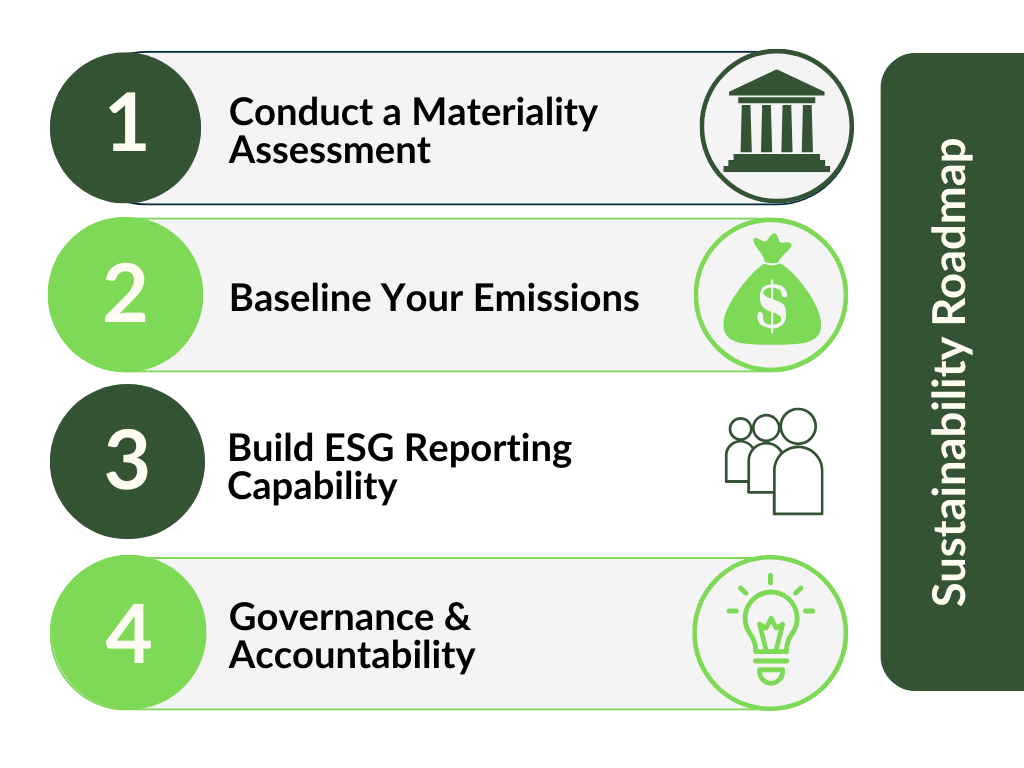As the global climate agenda intensifies, the UAE has taken decisive steps to position itself not just as a sustainability advocate—but as a regulatory leader. New mandates introduced by federal regulators now make sustainability disclosure and ESG reporting mandatory across a growing range of sectors.
For GCC businesses—especially those operating in construction, manufacturing, energy, logistics, and finance—this marks a pivotal moment. You’re now expected to move from vague sustainability intent to measurable, verifiable action.
What’s Changing in UAE’s Regulatory Landscape?
The UAE Securities and Commodities Authority (SCA), along with the Dubai Financial Market (DFM), has rolled out frameworks that make ESG reporting a legal obligation for listed companies. Meanwhile, regulators like ADGM, DIFC, and the MOCCAE are embedding climate disclosures deeper into national strategy.
Key Frameworks in Play:
- ISSB (International Sustainability Standards Board)
- TCFD (Task Force on Climate-related Financial Disclosures)
- GRI (Global Reporting Initiative)
- SASB (Sustainability Accounting Standards Board)
Effective Timeline: Most large businesses must begin reporting from FY 2025, with first submissions expected by Q1 2026. Smaller businesses will follow by 2027.
Who’s Impacted?
These regulations are not just for public companies. Expect increasing trickle-down to:
- ISSB (International Sustainability Standards Board)
- TCFD (Task Force on Climate-related Financial Disclosures)
- GRI (Global Reporting Initiative)
- SASB (Sustainability Accounting Standards Board)
Why This Mandate is a Business Game-Changer
- Access to Capital
Global investors—especially sovereign funds, venture capital, and private equity—are prioritizing ESG-aligned portfolios. Lack of disclosure may make your company invisible to institutional capital.
E.g., Abu Dhabi’s Mubadala now mandates ESG risk assessments for all funded projects. - Export Risk: EU’s Carbon Border Adjustment Mechanism (CBAM)
If you export to Europe (aluminum, steel, cement, fertilizer, etc.), you’ll need verified carbon intensity data to avoid cross-border tariffs.
- Government Tender Eligibility
Major infrastructure tenders (RTA, DEWA, ADNOC) are embedding ESG scoring into procurement frameworks.
Construction firms without baseline ESG policies may now score lower in prequalification rounds.
Preparing for Disclosure: A Roadmap
Here’s how to get your business ready:
- Conduct a Materiality Assessment :
This process helps businesses identify which ESG topics are most relevant to their specific industry and stakeholder ecosystem. Rather than trying to address every sustainability issue under the sun, companies should focus on the areas that directly affect their operations or pose the greatest risk and opportunity.
This requires engagement across departments—from finance and operations to HR and procurement—as well as external stakeholders like investors, customers, and even suppliers. The result is a clear picture of what matters most, allowing organizations to prioritize and tailor their sustainability strategy accordingly. - Baseline Your Emissions :
This involves calculating Scope 1 (direct) and Scope 2 (indirect, energy-related) emissions using internationally recognized methods such as the GHG Protocol. While Scope 3 emissions—those from the broader value chain—are more complex, businesses should begin mapping them, especially if they are in high-impact industries like construction, logistics, or energy.
- Build Your ESG Reporting Capability
This means aligning with a globally recognized disclosure framework that fits their objectives. For instance, GRI (Global Reporting Initiative) is ideal for stakeholder-focused transparency, SASB (Sustainability Accounting Standards Board) is tailored for investor relevance, and ISSB (International Sustainability Standards Board) provides a globally harmonized standard.
Regardless of the framework, it’s critical to move away from manual spreadsheets and towards dedicated ESG data management platforms that can automate data collection, track KPIs over time, and reduce reporting errors. By institutionalizing ESG data collection and reporting processes, businesses ensure that they are not just reactive to mandates, but proactively managing performance and accountability.
- Governance & Accountability
This means assigning ownership of ESG at the leadership level—whether through a dedicated Chief Sustainability Officer, a cross-functional ESG committee, or board-level oversight.
Governance also includes embedding ESG priorities into executive KPIs, integrating climate and social risks into enterprise risk management, and formalizing internal policies on emissions, ethics, labor practices, and supply chain standards. When ESG becomes a standing agenda item at the boardroom level, it shifts from being a reporting requirement to a business driver.

GCC Context: UAE Leading, Others Following
While the UAE is ahead, other GCC countries like Saudi Arabia and Qatar are close behind with similar ESG frameworks emerging. UAE’s mandates are expected to set the benchmark for the entire region, especially in sectors like energy, logistics, and construction.
Final Thoughts: ESG is Not a Report—It’s Strategy
If you treat ESG as a compliance headache, you’ll miss the bigger opportunity.
The UAE is making it clear: Sustainability will shape access to capital, contracts, credibility—and eventually, competitiveness.
Need help getting started?
We support GCC businesses with ESG materiality mapping, emissions calculations, report writing, and digital ESG tool setup.
